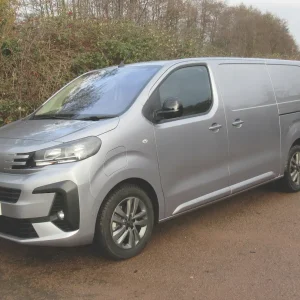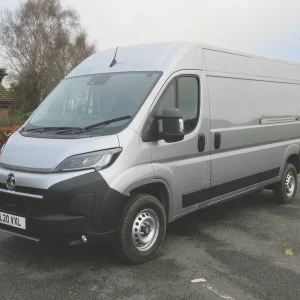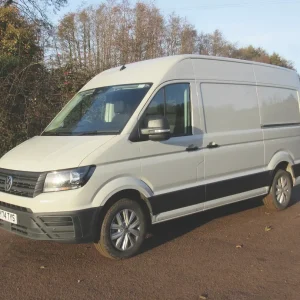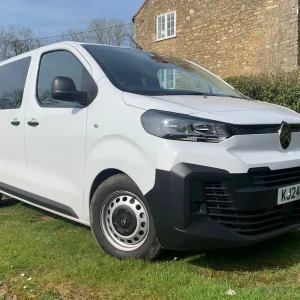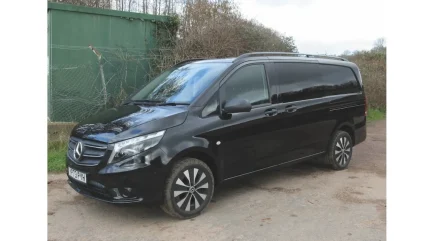
If you are self-employed or run a small business then every penny counts. So if you can acquire a vehicle that can double as a workhorse and transport for yourself and four or five family members, then that is what you will try to do.
The same sort of vehicle might well appeal to fleet operators who need to transport a gang of workers in comfort and safety along with their tools. Gone are the days – hopefully – when workers could be bundled into the back of a panel van and expected to travel squatting on sandbags, with no seats or seatbelts and zero attention paid to safety.
Hence the rise of the crew or kombi van; a van with front and rear seats that can accommodate half a dozen people or more, and a cargo area at the back usually separated from the cabin by a bulkhead. Most light commercial manufacturers have one or more in their arsenal, of different sizes and offering varying degrees of passenger and cargo space.
A high level of specification is especially important for individuals who want to use a crew van as their personal as well as their work transport. That is something that has been clearly recognised by Mercedes-Benz with its introduction of the six-seater (three in the front, three in the back) rear-wheel-drive Vito 119 L2 Premium Night Edition.
Based on the short-wheelbase (3,200mm) model, and powered by a beefy 2.0-litre diesel – a pleasant change from the multiple drawbacks of battery-electric traction – it boasts plenty of extra goodies with driver and passenger comfort and safety in mind.
Mercedes also offers crew vans on the longer (3,430mm) L3 wheelbase, in Pro or Select trim, and with the 163hp version of the 2.0-litre engine.
Load bay
Entry to the cargo area is by means of a glazed hatch-type rear door. A light at the bottom of the door illuminates when you open it as a safety precaution if you are loading or unloading the vehicle at night.
A lot depends on the use to which the vehicle is being put, but on balance we would prefer to see a bulkhead fitted. Its absence in this case means that rear seat passengers could be vulnerable to being walloped if whatever is being carried in the load bay shoots forwards under heavy braking.
On a more positive note, the load area is well-protected against minor scratches and scrapes by a combination of carpeting and plastic mouldings. The back seats are removable which means it can be expanded if you need to shift anything bulky and there is no shortage of cargo tie-down points.
Access to the rear seats is by means of sliding doors on each side of the vehicle with tinted windows and the occupants will find there is no shortage of space.
Interior and equipment
Satellite navigation and voice activation are included in an infotainment package that allows you to mirror your smartphone and is controlled through a rather small touch-screen. Air-conditioning is included in the deal and the driver and front passenger seats are heated.
Two USB sockets are provided, and you will find a 12v power point at the bottom of the dashboard.
Other features include front fog lights, driver and front passenger airbags, electric front windows, and heated and electrically-adjustable exterior rear view mirrors which fold in and out automatically.
Storage facilities include a deep, lockable glovebox, three shelves on top of the dashboard, and bins with a moulding that can grasp a flask in each of the front doors, along with a small shelf. You will find a couple of cup-holders on top of the fascia.
Small cubbyholes are located either side of the chunky, easy-to-use, heating and ventilation controls. No need to spend ages hopefully prodding a touchscreen just because you want to turn the heating up a notch.
The driver’s seat comes with a lumbar support and is height-adjustable, as is the leather-trimmed steering wheel.
A stop/start system is installed which should help keep down fuel consumption.
Safety measures include a reversing camera and parking sensors.
A sensor display on top of the fascia warns you if you are getting too close to an obstacle ahead of you with a combination of warning lights and beeps. It is at the heart of Active Brake Assist, which applies the brakes if the driver fails to react to the alerts signalled.
Included in a comprehensive package of safety devices, Attention Assist detects signs of drowsiness while Active Lane Keeping Assist triggers an alert if Vito wanders out of lane. Tyre Pressure Monitoring System will let you know if a tyre is starting to deflate so that you can take appropriate action.
A stalk on the steering column is used to activate cruise control, which includes a speed-limiter. Traction control is fitted, and can be switched off.
Security measures include tow-away protection, which can of course be deactivated.
In a sensible initiative, the Vito comes with Mercedes me which allows you to monitor your vehicle remotely using your smartphone, tablet or laptop. Free for the first three years, it, among other things, allows you to locate it and lock and unlock the doors even though you are not in the vehicle’s vicinity.
Powertrain
Equipped with a two-stage turbocharger with variable turbine geometry, Vito’s four-cylinder diesel pumps out its maximum output of 190hp at from 3,800rpm to 4,200rpm. Maximum torque of 440Nm bites across a 1,350rpm-to-2,600rpm plateau and a nine-speed automatic gearbox is standard with this engine.
AdBlue is used to help ensure compliance with the Euro 6 exhaust emission regulations and is held in a 24-litre reservoir.
Driving
Why on earth does Mercedes still insist on equipping the Vito with such a peculiar parking brake?
To apply it, you press a small pedal in the footwell. To release it, you tug a lever on the dashboard to the accompaniment of a loud bang.
It’s all very odd, idiosyncratic and rather unnecessary.
With the Vito’s automatic transmission you use a stalk on the steering column to engage Drive, Reverse or Neutral. One potential drawback of this approach is that you will confuse it with a windscreen wiper; something we did on a couple of occasions until we got more comfortable with this approach.
If you want to switch to manual then you press the Dynamic button on the dashboard which allows you to go up and down the box using paddles on either side of the steering column. You can go manual while Vito is still in automatic Drive mode if you so wish, but if you do so you will not always be permitted to change to a higher or lower gear.
The Dynamic button also allows you to choose from two power settings: Comfort and Sport.
The former is fine for most applications, and allowed us to accelerate up some of the steepest hills in Gloucestershire’s Forest of Dean without any loss of momentum,
even when heavily laden. The latter delivers some real punch, and as a potential licence-loser should be employed with caution.
We stuck with the Vito’s automatic setting for most of our time with the vehicle. We found the manual paddles awkward to use, and took quite a while to get familiar with them.
The Vito’s handling is safe and dependable enough, but tightening up the steering so it delivers more response would make it a lot sharper. The ride wasn’t overly impressive, with too much bumping, thumping and rumbling from the suspension.
Better sound insulation for the interior of the cabin wouldn’t come amiss, but noise wasn’t a serious issue.
Operating
The Vito is protected by a three year/unlimited mileage warranty with roadside assistance included for the duration. The MobiloVan assistance package in fact lasts for an extraordinary 30 years, albeit subject to terms and conditions.
Service intervals are set at two years/24,000 miles.
Fuel economy? We achieved around 36mpg, marginally better than the official WLTP (Worldwide Harmonised Light Vehicle Test Procedure) figure of 35.8mpg.
Good to see a spare wheel is provided. Not so good to see a lack of side rubbing strips, which leaves the vehicle’s lustrous black metallic paintwork vulnerable to knocks and dings.
Mercedes-Benz Vito 119 L2 Premium Crew Van Night Edition diesel
Price (ex VAT) £41,940
Price range (ex VAT) £40,385-£45,580
Gross payload 781kg
Load length 1664mm
Load width (min/max) 1270mm/1709mm
Load bay height 1252mm
Load volume 3.6m3
Loading height 558mm
Rear door aperture 1391mm x 1261mm
Side door aperture 822mm x 1252mm
Gross vehicle weight 3,000kg
Braked trailer towing weight 2,000kg
Engine size/power 1950cc, 190hp@ 3800-4200rpm
Torque 440Nm @ 1350-2600rpm
Gearbox 9sp auto
Fuel economy 35.8mpg
Fuel tank 70 litres
CO2 206g/km
Warranty 3yrs/unlimited mileage
Service intervals 2yrs/24,000 miles
Insurance group 43E
Price as tested £41,940
Rivals
Ford Transit Custom Kombi
Price range (ex VAT) £38,519-£42,354
Load volume 2.8-3.73
Gross payload TBC
Engines 110hp, 136hp, 170hp 2.0 diesel, 232hp 2.5 petrol plug-in hybrid, 100kw (136hp),
160kw (218hp) electric motor
Verdict: Having undergone an extensive revamp, and still a success story for Ford, the popular Transit Custom excels in all areas. Its ride, handling and performance are all top-notch, residual values are sound and it is backed by a comprehensive dealer network. In Kombi guise it can carry nine people. Check out the Double Cab-In-Van variant if you need to transport passengers and cargo.
Vauxhall Vivaro Doublecab
Price range (ex VAT) £31,555-£47,630
Load volume 3.2-4.03
Gross payload 915-1242kg
Engines 145hp 2.0 diesel, 100kW (136hp) electric
Verdict: Vauxhall is part of Stellantis, which also embraces Peugeot, Citroen, and Fiat Professional. Its entire light commercial line-up has recently received some extensive revisions under the Pro One banner. It’s a moot point as to how the different brands will be able to differentiate themselves from one another long-term. It is also worth noting that Toyota is employing Stellantis platforms for most of its light commercials courtesy of a joint-venture deal.
Volkswagen Transporter Kombi
Price range (ex VAT) £31,110-£47,070
Load volume (estimate) 2.8-3.63
Gross payload 852-1161kg
Engines 110hp, 150hp, 204hp 2.0 diesel
Verdict: Build quality is to a remarkable standard, and VW is a by-word for onboard safety systems. The five-seater Kombi is not an exception to the rule. Performance is exemplary, especially with the most-powerful diesel model, and the dual-clutch DSG cannot be faulted. A key drawback is the lack of a zero-emission electric model, but that omission will be rectified in the autumn when a new Transporter will be unveiled.
The Final Verdict
Design 7/10 – Smart and versatile – a two in one. But why retain that oddball parking brake?
Cabin 8/10 – Comfortable with plenty of passenger space
Ride 6/10 – Not its strongest suit, with too much grumbling and rumbling from the suspension
Refinement 7/10 – Noise levels could be better suppressed, but it’s not a deal-breaker
Load area 7/10 – Not sure about the lack of a bulkhead
Handling/performance 8/10 – Former is acceptable but could be sharper, latter is well on top of the job
Engine/transmission 7/10 – Well matched, but we found the manual steering wheel paddles awkward to use
Standard equipment 8/10 – No lack of useful kit, with the accent as always on safety
Operating costs 8/10 – Unlimited mileage warranty and roadside rescue service should keep costs down
What Van? subjective rating 8/10 – If you’re looking for a van for work and family, then this could be the one
Overall Rating = 74/100

